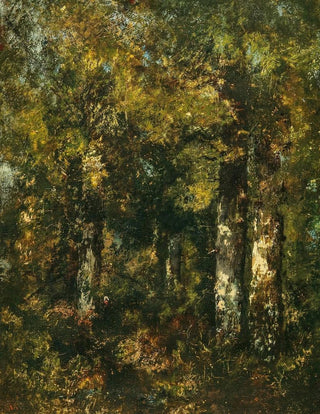Art print | In the Fontainebleau Forest - Narcisse Virgile Diaz de la Peña


View from behind

Frame (optional)
In a world where nature reveals itself in all its splendor, the artwork "In the Forest of Fontainebleau" by Narcisse Virgile Diaz de la Peña takes us to the heart of an enchanting landscape. Painted in the 19th century, this iconic piece showcases the artist's exceptional talent, capturing the magic and serenity of French forests. The vibrant colors and play of light create an almost tangible atmosphere, inviting the viewer to immerse themselves in this living tableau. The Forest of Fontainebleau, renowned for its majestic scenery, becomes the stage for a meeting between man and nature, where every tree, every ray of sunshine seems to whisper ancient secrets.
Style and uniqueness of the work
Diaz de la Peña's style is distinguished by its romantic and impressionist approach, blending realism and poetry. In this piece, he employs delicate brushstrokes to depict the texture of the foliage and the fluidity of shadows. Light plays a central role, illuminating specific areas while leaving others in gentle darkness. This technique creates a striking depth, encouraging the eye to explore every corner of the forest. The shades of green, brown, and gold harmonize beautifully, evoking the richness of biodiversity and the wild beauty of nature. The work is also characterized by a balanced composition, where natural elements harmonize with remarkable delicacy, demonstrating the artist's mastery.
The artist and his influence
Narcisse Virgile Diaz de la Peña, an emblematic figure of the Barbizon School, left a lasting mark on his era with his unique vision of nature. Influenced by the great masters of landscape painting, he developed a style that is his own, combining the precision of drawing with a palette of luminous colors. His commitment to nature and his desire to depict it faithfully earned him growing recognition within the Impressionist movement. Diaz de la Peña does not merely paint landscapes; he manages to infuse a soul into his works, making each painting a true visual poem. His influence endures, inspiring many contemporary artists who

Matte finish

View from behind

Frame (optional)
In a world where nature reveals itself in all its splendor, the artwork "In the Forest of Fontainebleau" by Narcisse Virgile Diaz de la Peña takes us to the heart of an enchanting landscape. Painted in the 19th century, this iconic piece showcases the artist's exceptional talent, capturing the magic and serenity of French forests. The vibrant colors and play of light create an almost tangible atmosphere, inviting the viewer to immerse themselves in this living tableau. The Forest of Fontainebleau, renowned for its majestic scenery, becomes the stage for a meeting between man and nature, where every tree, every ray of sunshine seems to whisper ancient secrets.
Style and uniqueness of the work
Diaz de la Peña's style is distinguished by its romantic and impressionist approach, blending realism and poetry. In this piece, he employs delicate brushstrokes to depict the texture of the foliage and the fluidity of shadows. Light plays a central role, illuminating specific areas while leaving others in gentle darkness. This technique creates a striking depth, encouraging the eye to explore every corner of the forest. The shades of green, brown, and gold harmonize beautifully, evoking the richness of biodiversity and the wild beauty of nature. The work is also characterized by a balanced composition, where natural elements harmonize with remarkable delicacy, demonstrating the artist's mastery.
The artist and his influence
Narcisse Virgile Diaz de la Peña, an emblematic figure of the Barbizon School, left a lasting mark on his era with his unique vision of nature. Influenced by the great masters of landscape painting, he developed a style that is his own, combining the precision of drawing with a palette of luminous colors. His commitment to nature and his desire to depict it faithfully earned him growing recognition within the Impressionist movement. Diaz de la Peña does not merely paint landscapes; he manages to infuse a soul into his works, making each painting a true visual poem. His influence endures, inspiring many contemporary artists who






